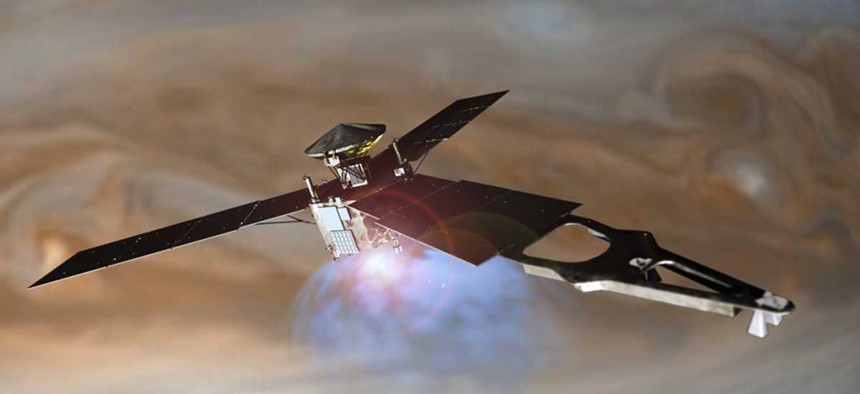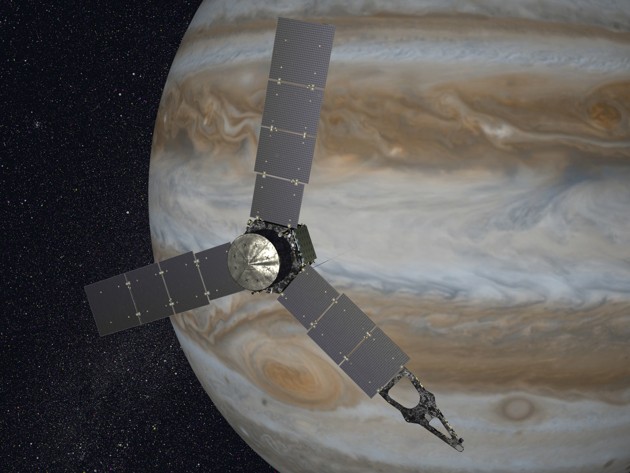
An artist's rendering of Juno during the orbital insertion Lockheed Martin
Juno’s Triumphant Night
After completing a high-risk maneuver, NASA’s spacecraft is officially in the gas giant’s orbit—and humankind is closer to Jupiter than ever before.
Scientists and space enthusiasts celebrated late Monday night as the spacecraft Juno successfully entered Jupiter’s orbit after five years and 1.7 billion miles of space travel.
“We just did the hardest thing NASA’s ever done,” Rick Nybakken, Juno’s project manager, could be heard telling his colleagues amid cheers in the moments after the spacecraft completed its task.
The successful maneuver, known as an orbital insertion, was executed via a series of pre-programmed commands that engineers transmitted hundreds of millions of miles to the outer solar system. The move, which represented the riskiest moment in the mission since Juno launched in August 2011, involved firing the spacecraft’s main engine so that the probe could slow down enough to leverage the planet’s gravity for a shift into its orbit.
Had things gone differently, Juno would have spun off into space. There was plenty else that could go wrong. The New York Times, for instance, kept this running list of doomsday possibilities in the hours leading up to the maneuver: “Juno blows up... The engine doesn’t fire at all... It crashes into something... It flies too close to Jupiter and is ripped to pieces... The computer crashes.”
Confirmation that the probe had successfully entered Jupiter’s orbit came with a curt three-second beep. About 45 minutes later, it was clear that the probe had cleared another key hurdle; its huge solar arrays had successfully turned back toward the sun—the necessary orientation to keep the spacecraft going. Now, Juno is embarking on a science mission that will take humankind closer to Jupiter than ever before, within about 2,600 miles of the planet’s cloud tops.
Even before tonight, however, Juno had already made history. It is the fastest human-made object ever built; at a speed of 165,000 miles per hour, it’s five times faster than New Horizons, seven times faster than Apollo 11, and 122 times faster than the Concorde. In January, Juno broke the record to become humanity’s most distant solar-powered envoy. “Prior to Juno, eight spacecraft have navigated the cold, harsh under-lit realities of deep space as far out as Jupiter,” NASA wrote at the time. “All have used nuclear power sources to get their job done.”

Now, planetary scientists on Earth will wait for Juno to complete a 53-day orbit, after which the probe will begin to transmit a heap of data about what it observes. Juno is set to orbit Jupiter 37 times in just under two years. “So much about the environment that we’ll have to withstand is unknown,” said Heidi Becker, an engineer at the Jet Propulsion Laboratory, in a video created by the agency. “Nothing’s really certain about what’s going to happen.”
Juno is equipped with cameras, an ultraviolet spectrograph, a magnetometer, a microwave radiometer, and other instruments that planetary scientists hope will help them understand the planet like never before. They want to determine what Jupiter is made of, how much water it contains, and how it formed in the first place.
“I view Jupiter as a missing link,” said Barry Mauk of the Johns Hopkins University Applied Physics Laboratory in a statement before the orbital insertion. “Juno is not only going to help us better understand Jupiter, it’s going to help us better understand the universe around us and our place in it.”
Jupiter has been called a solar system in its own right. It is enormous, with a diameter more than 11 times the size of Earth. Its magnetosphere is massive, stretching all the way to Saturn’s rings, and powers huge permanent auroras—“the most intense and interesting aurora in the entire solar system,” Mauk said. Even Jupiter’s famed Great Red Spot is three times the size of our planet. The gas giant also holds clues about the origins of the rest of the solar system, including early planets that once surrounded Jupiter.
“It’s a unique record for the outer solar system of what these protoplanets might have been like,” Jonathan Lunine, an astronomer at Cornell University, said in a statement. “We’re doing the astronomical equivalent of ‘broken pottery’ archaeology, trying to piece back together the original molecules and ice grains that got evaporated and dissociated inside Jupiter billions of years ago.”
NEXT STORY: Hillary Clinton Goes to the FBI






